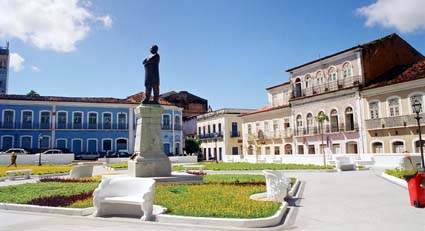 |
Sao Luis is one of the only three Brazilian capital cities built on an island, and this is a good starting point for tourism activities, but there's much more than that: Is was founded by the French in 1612, invaded by the Dutch some years later, and finally claimed by the Portuguese. The result is a mixture of culture like no other place in the country can show, an open-air museum filled with uncountable architectural elements, streets covered in stones, corners, narrow side streets, balconies, a mix of colonial architecture where tourists find stores, theaters, churches, museums, bars, restaurants and hotels. A place to love. |
Old Town (Centro Histórico) is the main touristic attraction in Sao Luis. It encompasses more than 3,500 colonial buildings from the 17th and 8th Centuries, distributed throughout the neighborhoods of Praia Grande, Desterro, and Portinho. Sao Luis is also known as the Brazilian capital of reggae music, with a warm weather all year round, even though locals consider January to june as winter months, due to the frequent rains, and july to December as summer. |
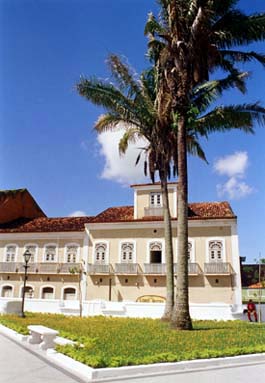 |
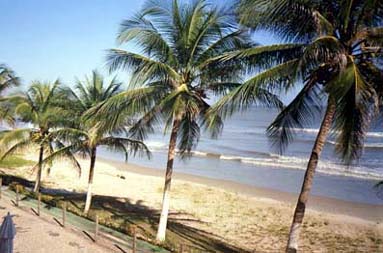 |
At left, palms and sand, located just outside our hotel room. When choosing a place to stay at, avoid downtown, which may be a great place to walk aroung, but is not the best option for lodging. Prefer to stay at Ponta da Areia quarter, where you will have the beach at your door step. |
Sao Luis has more than 3,000 listed buildings, most of them with facades decorated with the glazed tiles typical of the Portuguese colonial style. Among them are the Palácio dos Leoes (Lion Palace), which until 1615 was a fort which protected the then capital of Equinoctial France, as São Luis was called under French rule; the Catedral da Se, built by the Jesuits priests in 1726; the church of Carmo, one of the oldest in the city, constructed in 1627; and the Arthur Azevedo Theatre, built between 1815 and 1817 and thought to be the first theatre to be erected in a Brazilian capital. The profusion of colorful tiles was more than just charming as they were put in place to preserve the façades against the effects of the tropical temperatures, rain and sea wind. |
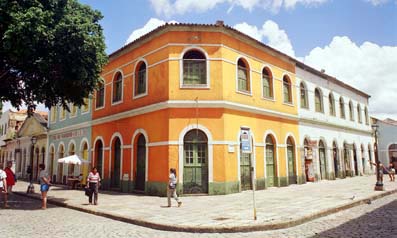 |
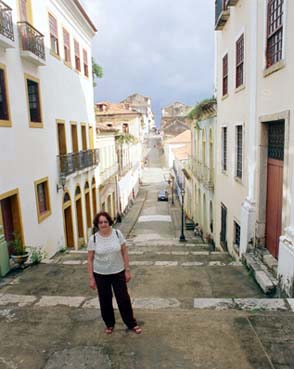 |
Left: Sao Luis downtown and one of its many narrow, old and steep streets, sided by historic mansions and buildings. |
At right, a view from Ponta da Areia (Sand Tip), taken from Palacio dos Leoes (Lion's Palace) balcony. At Ponta da Areia are the best beaches in town, making this the best option to stay. Palacio dos Leoes may be defined as Sao Luis Versailles Palace. Housing the government offices, many of its beautiful rooms are open to visitors. At the center of the photo, Amil River. |
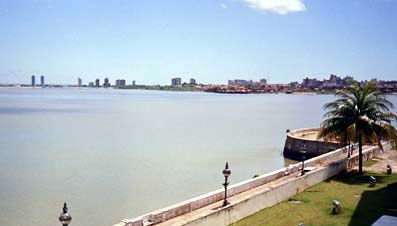 |
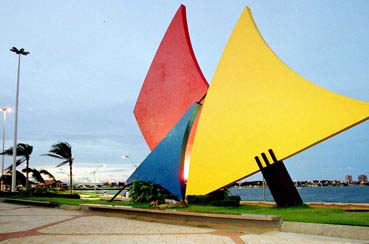 |
Lagoa da Jansen (Jansen Lake) is the right spot to be, if you would like to have a beer or soft drink while basking in the sun, or maybe hear some music on a summer’s night. It is an ecological park and a beautiful lake, surrounded by restaurants, sports courts, bike paths and a jogging trail. Also from Lagoa da Jansen you will get amazing views from the modern Sao Luis area. It is located next to the ocean beaches and the main luxury hotels in town. |
Again, a photo taken at Ponta da Areia beach, showing some modern residential building and parks located among Lagoa da Jansen and the ocean. |
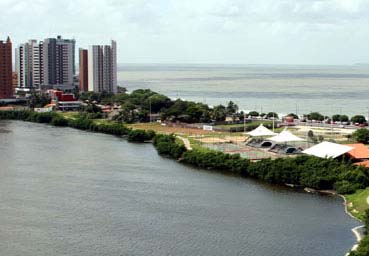 |
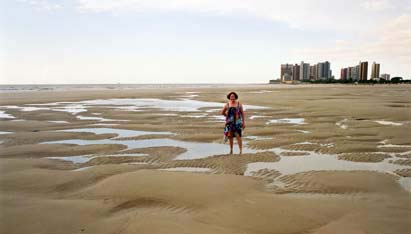 |
Did you know that Sao Luis is also famous for its tides? The height of high and low tides is second only to Mont Saint Michel area, in France. During low tides, you will be able to walk hundreds of meters over the dry ocean bed, and watch dozens of boats lying on the sand, making it all looks like a surrealistic painting. Apart from that, the sea at Sao Luis beaches has warm waters, making it a very pleasant option for those who enjoy swimming. At right, behind me, some residential buildings of modern Sao Luis area. |
A one day visit to Sao Luis must include at least the churches of Santo Antonio and Remedios, the Igreja Matriz, Gonçalves Dias Squares (left), commercial areas of Rua Grande, Ceprama Market (lovely wooden handcraft items), Casa do Maranhao ( Cultural Center), the Old Town, including some alleys and stairways as Beco Catarina Mina, La Ravadière Palace, build in 1689 by Frenchman Daniel de La Touche. Those who enjoy traditional shopping just need to head to São Luis Mall, with many restaurants, shops and movies. |
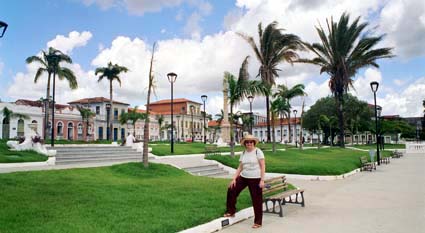
|
 |
Please remember Sao Luis is very very hot, and most of the tourist activities take place outdoors, with special emphasis on walks on stone paved streets. Opt for light clothes and comfortable walking shoes. It is also important to bring sun glasses, hats, and sunscreen, especially when visiting the beaches and the Old Town. A day tour to Alcantara is a nice jorney and an unforgetable cultural visit, but, depending on the sea tide, may get you seasick. |
|
At right, Portugal Street, at the heart of Old Town. Sao Luis greatest era of prosperity was reached in the second half of the eighteenth century, when cotton exports were at their height. During this period, the province of Maranha furnished a considerable part of the revenues of the Royal Treasury, beating various other provinces of the Portuguese empire.
|
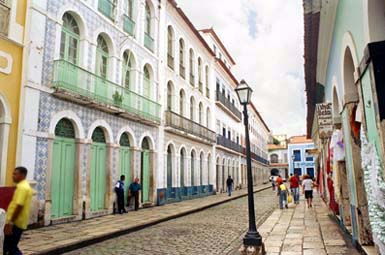 |
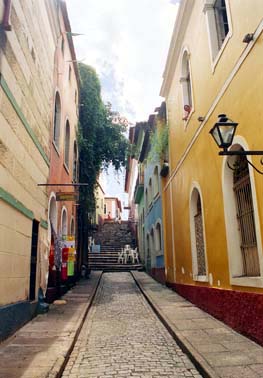 |
At left, one more narrow street from historic quarter, located downtown. |
This huge Ox is the most important character of Bumba Meu Boi festivities, which take place during the month of june. It is basically a dramatic dance, which tells the story of the death and resurrection of that ox, a farmer, the indians, and many more. This dramatization includes dancing, singing, choreographed movements, and much improvisation. If Rio has its Samba Schools, Sao Luis and all other towns in Maranhao State has their Bumba Groups, or just Bois. Some Boi groups are small, some have hundreds of people on it. Is spite of the name, there is no real ox, or any other animal on the groups, everything is played by people wearing every kind of costumes, and playing different styles of music, the so called Sotaques. Together, those groups and their dance, music and colored costumes creates a rhythmic beat that's extremely contagious and vibrant, making this something that you should not miss when coming to Sao Luis. |
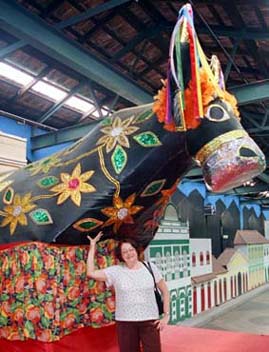 |
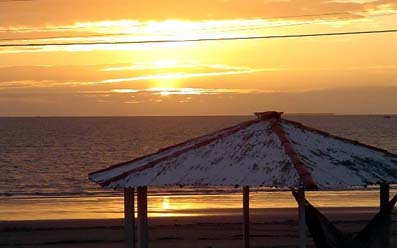
|
The city and island of Sao Luis is located right in the center of Maranhao coast line. Metro Sao Luis includes also the towns of Sao Jose de Ribamar, Paco do Lumiar and Raposa. Across the sea, the historical town of Alcantara, is also worth a visit. The best time to visit Sao Luis is on June, when many traditional festivities take place, including the most important of them all, the Bumba Meu Boi. |

Boi Bumbá
|
|
|